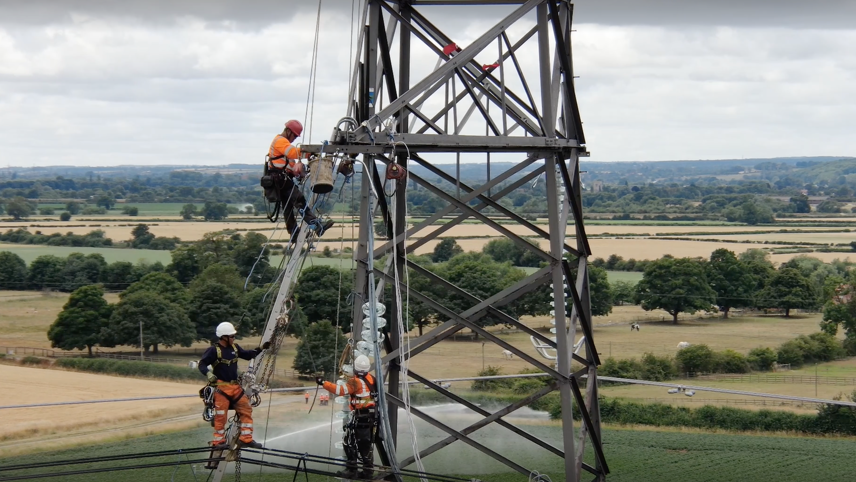You’ve reached your limit!
To continue enjoying Utility Week Innovate, brought to you in association with Utility Week Live or gain unlimited Utility Week site access choose the option that applies to you below:
Register to access Utility Week Innovate
- Get the latest insight on frontline business challenges
- Receive specialist sector newsletters to keep you informed
- Access our Utility Week Innovate content for free
- Join us in bringing collaborative innovation to life at Utility Week Live

National Grid has completed the first stage of a £130 million project to refurbish its overhead line network between Lincoln and Stevenage.
Work on the high-voltage wires – transporting electricity from Cottam Power Station, near Lincoln, to Wymondley Substation, near Stevenage, and passing near Newark, Stamford, Peterborough and Hitchin – started in March this year and will take two years.
National Grid’s operations teams and Morrison Energy Services have been working at heights of up to 50m to replace around 895 miles – or 1,440km – worth of overhead line installed in the 1960s and now approaching the end of its scheduled lifespan. While pylons tend to last for around 80 years, overhead line conductors, insulators and other fittings offer a lifespan of roughly half that.
In addition to replacing the overhead lines, specialist teams climbed and surveyed 248 pylons along the 170km route and fitted 52 tonnes of steel to reinforce the pylons to support the new line system. In total, engineers will have installed a further 1,670km of new overhead line once the project’s second phase finishes in 2023.
Upon completion, it is hoped that the new line will not only strengthen grid infrastructure from Lincolnshire through to Hertfordshire but also enable the network to continue transporting higher volumes of renewable power.

- Resilience, reliability and collaborative transformation to adopt technology and innovation are among the key themes at the Utility Week Forum, which will take place in London on 8-9 November. Find out more here.
How are pylons rewired?
With overhead lines comprising two circuits – one on each side of a pylon – refurbishment is carried out across two separate periods of work, one side at a time, so that the other circuit can be kept live.
Once work has completed on one side of the overhead line, the circuit is re-energised and the opposite side is switched off so that the work can be carried out on that side.
Each line is divided into sections of between 10 and 15 pylons – stretches of up to 5km – with old overhead lines dropped into temporary running blocks suspended from a pylon’s cross arms. Winches are then set up at either end of the wiring section.
The old overhead line is attached to the pulling winch and the new line is attached to the old one at the other end of the section through a tension winch. The new line is then pulled through the pylons using the old line with the tension winch serving as a ‘brake’ – keeping sufficient tension in the new lines while they are installed to prevent them falling.
Once pulled into position, the new line is secured with new insulators and spacers, with the process repeated on every 10 to 15 pylon section.
The Lincoln to Stevenage refurbishment forms part of National Grid’s £1 billion annual investment in maintaining and upgrading its infrastructure.
“This project is just one example of how our engineers work every day to maintain the electricity network in England and Wales,” Martin Bage, overhead lines engineer for National Grid said. “The excellent progress we are making on this refurbishment is testament to the skill and great teamwork of all involved.
“We look forward to completing the second half of the project and continuing our work ensuring our network can play its part in delivering safe and secure electricity.”
The completion of the first stage of National Grid’s £130 million project between Lincoln and Stevenage comes after it installed overhead wires onto the first of its redesigned T-pylons as part of a £900 million connection project carrying low carbon electricity from Hinkley Point C nuclear power station in Somerset in March.
All 48 T-pylons are to be energised this month, with construction of the remaining 68 project pylons to begin north of Sandford before the end of 2022 – with stringing slated for 2023.
 Utility Week Innovate, in collaboration with Utility Week Live aims to discover and promote innovative approaches to tackle front line business challenges through case studies, technical/project studies, networking, and live content. Be recognised as a key solution provider and meet your target audience face-to-face at UWL23. Find out more about exhibiting
Utility Week Innovate, in collaboration with Utility Week Live aims to discover and promote innovative approaches to tackle front line business challenges through case studies, technical/project studies, networking, and live content. Be recognised as a key solution provider and meet your target audience face-to-face at UWL23. Find out more about exhibiting
Please login or Register to leave a comment.